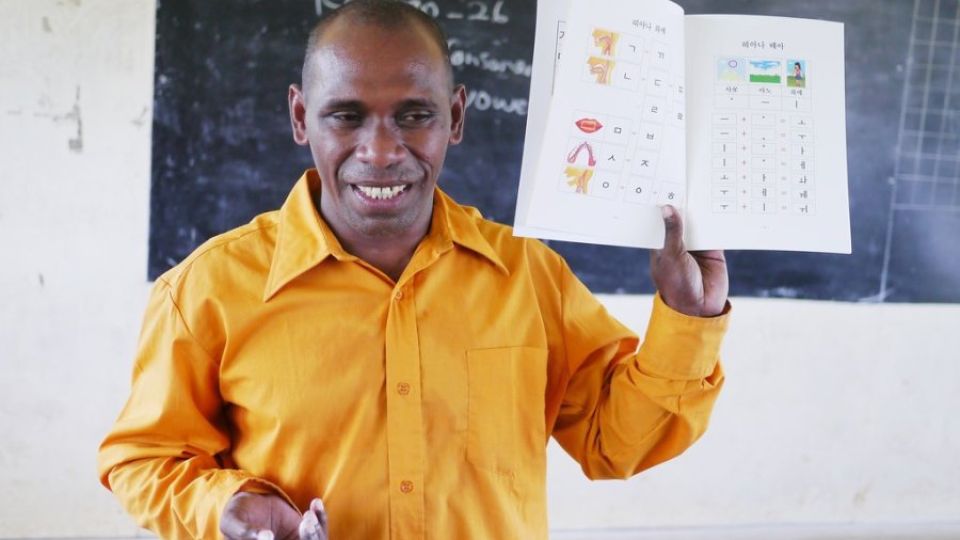April 10, 2023
SEOUL – Javin Rukia, a 49-year-old English teacher at a middle school in the Solomon Islands, used to teach Hangeul, the writing system for the Korean language, about a decade ago.
It was when two provinces in the island country — Guadalcanal and Malaita — chose Hangeul as their official alphabet for transcribing their indigenous languages which had been passed down orally but did not have a writing system.
The southwestern Pacific archipelago, made up of 992 islands, is one of the most linguistically diverse areas in the world. There are more than 70 different languages spoken throughout the Solomon Islands. English is its official language, but only 1-2 percent of its total population can communicate fluently in it.
To preserve indigenous languages, Guadalcanal and Malaita provinces respectively launched a pilot program in October 2012 to teach middle and high school students how to read and write their native tongues — Ghari and Kwara’ae — using Hangeul.
For Korean linguists, it was the second major project to share King Sejong the Great’s invention as a writing system for languages other than Korean. The first such project focused on Cia Cia, a language spoken principally around the city of Baubau, Indonesia. The Cia Cia tribe embraced the Korean alphabet as a tool to read and write their language in 2009.
The Solomon Islands project was first proposed in 2011 by the UN Global Compact Network Korea, which sought to improve literacy among the world’s minority groups speaking indigenous languages.
A virtuous cycle of enhanced literacy, better quality of education, economic advancement and alleviation of poverty was the campaign’s ultimate goal, according to the Seoul National University Center for Humanities Information, which supported the project through teacher training and the publication of textbooks.
As of last year, the Solomon Islands’ adult literacy rate stood at 76.6 percent, according to data from UNESCO.
Rukia was one of the two local teachers who participated in the program. After taking Korean language courses at Seoul National University during the March-May period in 2012, he started to offer Hangeul lessons at a middle school in Malaita province later that year using a textbook developed by linguistics professors at the university.
Nearly 50,000 residents in Malaita province speak Kwara’ae as their first language.
Composed of writing, speaking and reading sections, the SNU textbook introduced the Korean alphabet and explained the province’s history and culture in Korean.
“Since Hangeul is a phonetic script which has a correspondence between letters and sounds, it was recognized as an effective writing system to (preserve) the province’s spoken language,” Rukia told The Korea Herald.
How it failed
The language preservation project in the Solomon Islands, however, didn’t last long.
The project was halted less than a year after its launch, largely due to financial difficulties, according to professor Lee Ho-young, who led the development of textbooks as then director of the SNU Center for Humanities Information.
“To publish textbooks and train local teachers, we needed a budget of around 400-500 million won ($304,683-$380,853) each year,” the linguistics professor told The Korea Herald.
But the project failed to receive sufficient financial backing from UN Global Compact member organizations or from bodies like the Solomon Islands’ provincial governments.
Lee said the Seoul-based university had shouldered the cost of developing textbooks — around 70 million won. As funds dwindled, he even used his personal funds, but eventually he had to admit that continuing the project would be impossible.
The professor recalled that the apparent lack of enthusiasm from recipients of the project was another unexpected challenge.
“In order for the project to succeed, it was crucial for the local people to have a strong desire to (learn how to write to) preserve their native languages. But their demand for the education was not as high as we had expected,” Lee said.
Even with strong financial and systematic backing, an educational support project will fail to produce positive outcomes if the intended beneficiaries do not perceive its benefits, he noted.
Despite the setback, Lee has maintained his perspective as a linguist that Hangeul is highly applicable as a script for indigenous languages spoken by diverse ethnic groups in the Solomon Islands.
As for skeptics who see the efforts to spread Hangeul to ethnic minorities as inherently problematic or even propagandistic, the professor asserted it was not.
Rather, the case of the Solomon Islands may attest to the difficulties and challenges of achieving success in any such effort, as it requires sensitivity, respect and a genuine desire to share and preserve cultural and linguistic heritage from both the disseminating party and the recipient group.
“There was demand from many government officials and education experts in the Solomon Islands for education about native languages. They also actively sought cultural exchanges with Korea, when the Hangeul education system was launched.”
Lee pointed to the Cia Cia people’s adoption of the Korean alphabet. Despite the initial challenges, the group has embraced the writing system and used it to improve their lives.
“The Cia Cia group takes pride in being able to write and read their spoken language through Hangeul. Korea did not force them to have such pride. We just responded to their demand for a writing system and provided support,” he said.
Meanwhile, Rukia hopes for a revival of the Hangeul project in his country.
“Currently, schools don’t teach students Korean letters, but I still have the textbook to use whenever I have the opportunity. I did enjoy teaching Hangeul,” he said.


